Would you like a cup of tea with using a Rococo Naturalistic Spoon ?
The Rococo Naturalistic Spoon is a specific type of spoon having a leaf-shaped bowl or stem which reflects Rococo Naturalism - the combination of enthusiastic interest in precisely imitating natural forms and fantasy - invented by Huguenots silversmiths around mid 1730s. Most of the many varieties of naturalistic spoons are teaspoons using leaf, flower, and sometimes insect motiefs - ladybirds and caterpillars.
 A pair of Meissen porcelain herons made in 1732 for the Japanese Palace in Dresden,
Germany; at Christie’s Paris in June 2005, they fetched $6.8 million.One of the key components of Rococo Naturalism is the realism. The passion to imitate natural forms as precisely as possible was clearly exhibited on the Japanese Palace project ordered by Augustus the Strong (1694-1733), Elector of Saxony and King of Poland, one of the wealthiest monarchs and most important patrons of the arts of his age. In 1730 he planed to fill the upper floor of the Japanese Palace in Dresden with a large group of porcelain animals and birds made by the Meissen Porcelain factory. In the other words he intended to established a Zoo with various porcelain animals and birds as a natural historian. This project still remains unparalleled in the history of ceramics. The order for these large beasts came only 20 years after the foundation of the Meissen factory, the first European factory to succeed in the manufacture of hard-paste porcelain. Meissen's discovery of the means of making porcelain was the direct result of Augustus the Strong's passion for imported the Far Eastern ware - Japanese Imari and Chinese Porcelain, which led him to amass a collection of over 20,000 pieces, and to employ the alchemist J. F. Böttger to discover the formula for this 'white gold'. According to a list of 1734 as many as 597 animals and birds were projected for the palace. While in the event this quantity of figures was not realised, an inventory lists as many as 458 examples at Dresden in 1736. Their production became such a drain on the factory's output and resources that work on the scheme was abandoned sometime before 1739. The monumental Japanese Palace project was carried out by the most famous modeler, Johann Joachim Kaedler, at Meissen Porcelain factory.
A pair of Meissen porcelain herons made in 1732 for the Japanese Palace in Dresden,
Germany; at Christie’s Paris in June 2005, they fetched $6.8 million.One of the key components of Rococo Naturalism is the realism. The passion to imitate natural forms as precisely as possible was clearly exhibited on the Japanese Palace project ordered by Augustus the Strong (1694-1733), Elector of Saxony and King of Poland, one of the wealthiest monarchs and most important patrons of the arts of his age. In 1730 he planed to fill the upper floor of the Japanese Palace in Dresden with a large group of porcelain animals and birds made by the Meissen Porcelain factory. In the other words he intended to established a Zoo with various porcelain animals and birds as a natural historian. This project still remains unparalleled in the history of ceramics. The order for these large beasts came only 20 years after the foundation of the Meissen factory, the first European factory to succeed in the manufacture of hard-paste porcelain. Meissen's discovery of the means of making porcelain was the direct result of Augustus the Strong's passion for imported the Far Eastern ware - Japanese Imari and Chinese Porcelain, which led him to amass a collection of over 20,000 pieces, and to employ the alchemist J. F. Böttger to discover the formula for this 'white gold'. According to a list of 1734 as many as 597 animals and birds were projected for the palace. While in the event this quantity of figures was not realised, an inventory lists as many as 458 examples at Dresden in 1736. Their production became such a drain on the factory's output and resources that work on the scheme was abandoned sometime before 1739. The monumental Japanese Palace project was carried out by the most famous modeler, Johann Joachim Kaedler, at Meissen Porcelain factory.
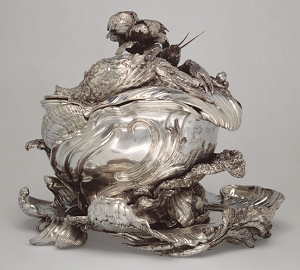 A Silver Tureen, Stand and Cover designed by Juste-Aurèle Meissonnier, executed by Pierre-François Bonnestrenne and Henry Adnet, Paris, 1735-1740. (36.9 by 45.6 by 38 cm.)Rococo Naturalism- the invention applying precise natural forms as components of Rococo style design on dairy utensils - was originated by Juste-Aurèle Meissonnier (1695-1750). He was described by one of his contemporaries as "an unruly genius, and, what's more, spoilt by Italy", active in Paris as a goldsmith, sculptor, painter, architect, furniture designer, and designer for porcelain of Manufacture de Porcelaine at Chantilly. His famous silver works, two tureens for Duke of Kingston, clearly illustrate his special interest to apply precise natural forms as components of totaly harmonized Rococo design, which must be inspired by the Japanese Palace Project at Meissen as his competitor, and also Japanese "Imari" porcelain and japan laquerware "Maki-e" collectioned by French royal family since 17th century.
A Silver Tureen, Stand and Cover designed by Juste-Aurèle Meissonnier, executed by Pierre-François Bonnestrenne and Henry Adnet, Paris, 1735-1740. (36.9 by 45.6 by 38 cm.)Rococo Naturalism- the invention applying precise natural forms as components of Rococo style design on dairy utensils - was originated by Juste-Aurèle Meissonnier (1695-1750). He was described by one of his contemporaries as "an unruly genius, and, what's more, spoilt by Italy", active in Paris as a goldsmith, sculptor, painter, architect, furniture designer, and designer for porcelain of Manufacture de Porcelaine at Chantilly. His famous silver works, two tureens for Duke of Kingston, clearly illustrate his special interest to apply precise natural forms as components of totaly harmonized Rococo design, which must be inspired by the Japanese Palace Project at Meissen as his competitor, and also Japanese "Imari" porcelain and japan laquerware "Maki-e" collectioned by French royal family since 17th century.
Rococo Naturalism and the modeling techniques from actual lives were imitated by Nicholas Sprimont (1716-1771), a Liègeois Huguenot, who moved to London early in 1742. He became a leading pracstitioner of the rococo style as a silversmith and also a porcelain maker at the Chelsea Porcelain Factory. His most famous work, two of the crayfish salt for Frederick, Prince of Wales in the Royal Collection were served as a prototype for porcelain versions subsequently reproduced by the factory. The accompanying spoons for the crayfish salts are modelled as branches of coral with cockleshell bowls.
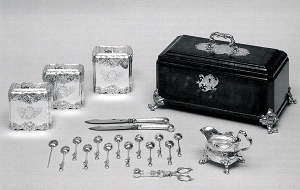 Tea Equipage by Paul de Lamerie, 1735. It has a set of 12 cast whiplash pattern teaspoons, a mote spoon, an unusual pair of tea tongs, a set of twelve tea knives, two tea caddies, a sugar caddy and a milk jug; all these are housed in an elegant, silver mounted, fitted shagreen box. Paul de Lamerie (1688-1751), Holland born Huguenot silversmith, established Rococo style in English silverware, before Nichols Sprimont came there with Rococo Naturalism from France. His Tea Equipage dated to 1735 contains a set of 12 cast whiplash pattern teaspoons, which would be attributed to the origin of Grand Rococo pattern, which featured all of pure Rococo characteristics like asymmetry floriate 'S' curve shaped ornament on the stem, the shell shaped bowl with rocaille decorations on its back.
Tea Equipage by Paul de Lamerie, 1735. It has a set of 12 cast whiplash pattern teaspoons, a mote spoon, an unusual pair of tea tongs, a set of twelve tea knives, two tea caddies, a sugar caddy and a milk jug; all these are housed in an elegant, silver mounted, fitted shagreen box. Paul de Lamerie (1688-1751), Holland born Huguenot silversmith, established Rococo style in English silverware, before Nichols Sprimont came there with Rococo Naturalism from France. His Tea Equipage dated to 1735 contains a set of 12 cast whiplash pattern teaspoons, which would be attributed to the origin of Grand Rococo pattern, which featured all of pure Rococo characteristics like asymmetry floriate 'S' curve shaped ornament on the stem, the shell shaped bowl with rocaille decorations on its back.
The Maynard dish by Paul de Lamerie, London, 1736In 1736 Maynard Master, known to be an unidentified greatest silversmith executing Rococo style at its highest quality, started to work for Paul de Lamerie. In 1739, he made a famous set of four cast salts with accompanying spoons illustrates the marriage of naturalism and fantasy which is the essencial characteristic of the Rococo Naturalism. Each salt is conceived as a abalone shell supported by a mermaid draped in netting, encrusted with sea shells and coral. These spoons might be the prototype of the Rococo Naturalistic spoon.
Who is this highly important and enigmatic Maynard Master? Who can figure out this pazzle could be Charles Frederick Kandler. He was believed to be a younger brother of Johann Joachim Kaedler, the famous modeler at Meissen Porcelain factory ! If so, the enigmatic circle of Rococo Naturalism would be completed.
Gold Tea-spoons and Tea-Tongs by Francis Harrache, circa 1740. Victoria & Albert Museum Huguenots small-work silversmiths, like Francis Harrache (1710-1757) and John (I) Derussat (1700?-1758?), belonged to Huguenots community at Soho area of London, invented the Grand Rococo pattern tea-spoon, and developed it to the Rococo Naturalistic Spoon which has a twig-shaped stem wearing tea leaves and a leaf-shaped bowl with insect motiefs - ladybirds and caterpillars, by applying enthusiastic naturalism and fantasy on highly fashionable utensils for Tea ceremony at Salon.
Tea Equipage consists of Rococo Naturalistic Spoons and a pair of sugar tongs was undoubtedly the most sophisticated items for serving tea among nobles in the Huguenots community leading the social and cultural movements in mid 18th century England.
Rococo Revival Period Naturalistic Teaspoon by Joseph Willmore, Birmingham, 1830. from my gallery.The Naturalistic Spoon was re-discovered and re-invented through the history - Rococo revival in 1830s, Japonisme in 1880s, and Art Nouveau around 1900. Nature and close encounters of other kinds of cultural identities are always the wellspring of human creativity. Life's diversity is essential for our future.
In this site, I intend to present various aspects of the naturalistic spoon and forcus on its extream uniqueness, beauty and value in the history of silver, art, tea and society. I could not find out any specific research or comprehansive collection focusing on this theme. Given very limited information I might commit mistakes or misunderstandings. So I welcome any information, enquiries or critics.
The naturalistic spoon is a small, beautiful and fluent story-teller whispering you various interesting stories including the history of tea, silver,society, design, cultural relationship between Europe and Japan, and more.
I hope you would enjoy a flavor of Rococo !
Seiji Yamauchi
 Top
Top Site Map
Site Map References
References About Me
About Me
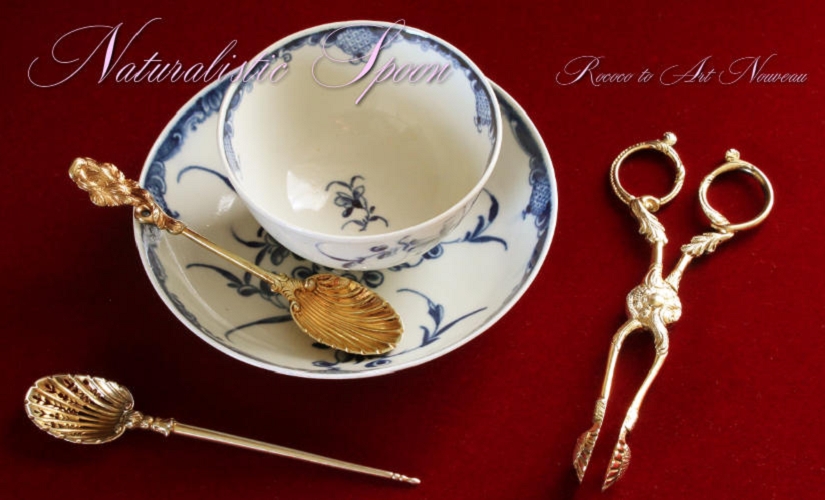
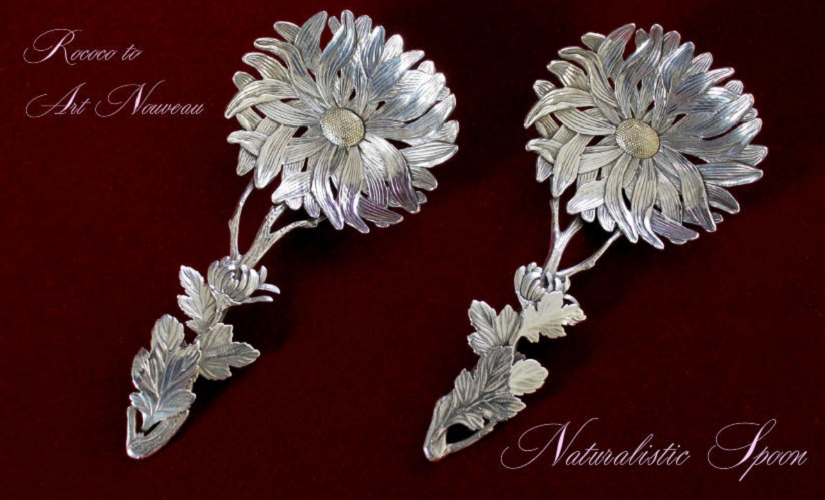
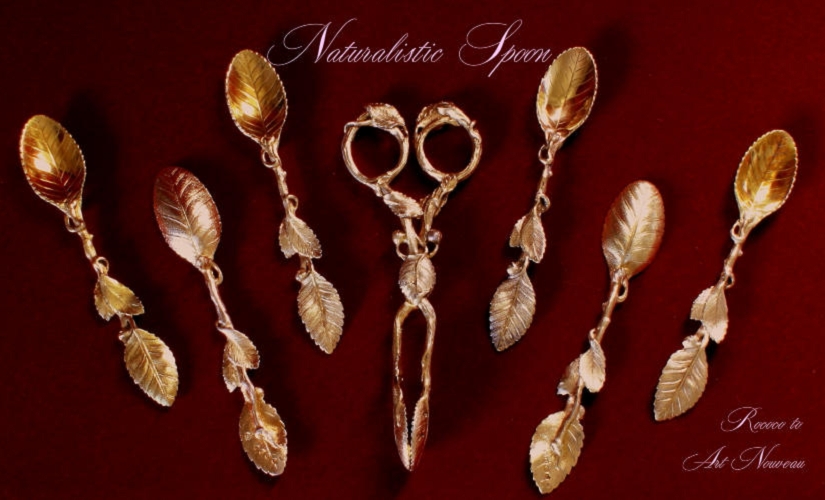
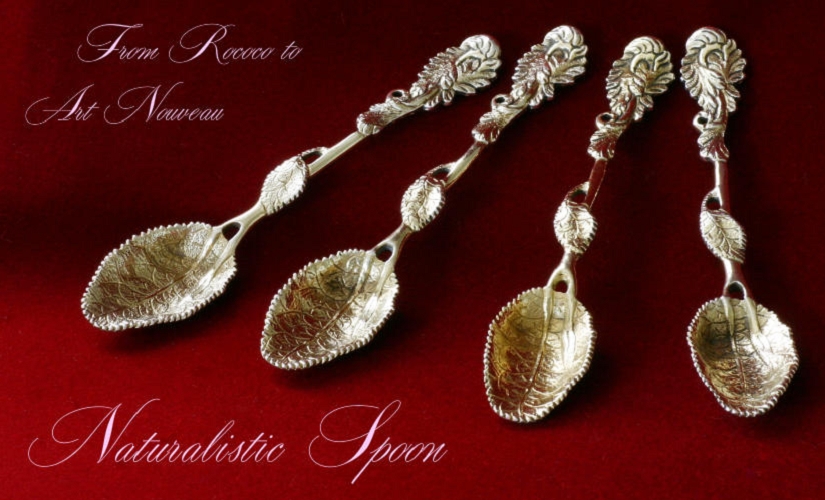
![[Most Recent Quotes from www.kitco.com]](http://www.kitconet.com/images/quotes_special.gif)
